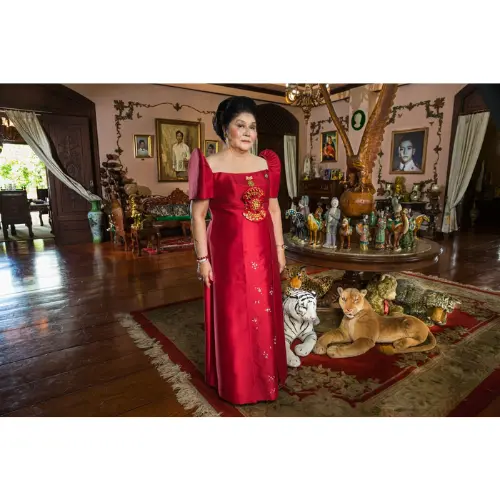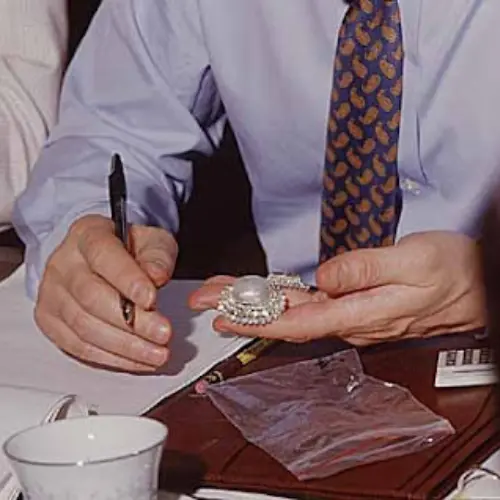
Imelda Marcos, the former First Lady of the Philippines, is perhaps best known for her opulent lifestyle, with one of the most conspicuous aspects being her extensive and extravagant jewelry collection. Imelda Marcos' jewelry not only symbolises the excesses of her time in power but also serves as a testament to the remarkable wealth amassed during the Marcos regime. This blog will delve into the fascinating world of Imelda Marcos' jewelry, exploring its origins, significance, and the controversy surrounding its acquisition.
The Origins of Imelda's Jewelry Collection
Imelda Marcos was not born into wealth, but her marriage to Ferdinand Marcos, who later became the President of the Philippines, catapulted her into a life of luxury and excess. As the First Lady, Imelda gained access to immense wealth, which she unabashedly displayed through her wardrobe, real estate holdings, and, of course, her dazzling jewelry collection.


Imelda's affinity for jewelry was evident early on, and her collection grew exponentially during the 21-year rule of Ferdinand Marcos. The pieces in her possession ranged from rare gemstones to custom-made creations from renowned jewelers around the world. Some of her most iconic jewelry items included necklaces, bracelets, rings, and tiaras adorned with diamonds, emeralds, sapphires, and pearls.
The Marcos Jewelry Trove: Hawaii, Malacañang, and Roumeliotes Collections

Embark on a captivating journey through the glittering chapters of the Marcos era with the Hawaii, Malacañang, and Roumeliotes collections – three troves of opulence sequestered by the Presidential Commission on Good Government (PCGG). The "Hawaii collection" narrates the tale of jewels seized by the US Bureau of Customs during the Marcoses' exile in 1986. Meanwhile, the "Malacañang collection" unveils treasures discovered in the hasty departure from Malacañang Palace. Lastly, the "Roumeliotes collection" recounts the jewels confiscated from Demetriou Roumeliotes, a close associate of Imelda Marcos, attempting a daring escape from Manila International Airport.
Valued at ₱1 Billion (approximately $21 million), these collections stand as relics of excess and are set to be auctioned after three decades in government custody. Unveil the mystique, glamour, and legal pursuit surrounding these glittering enigmas that once adorned the Marcos regime.
Significance and Symbolism

Imelda Marcos used her jewelry not only as a personal adornment but also as a symbol of power, prestige, and influence. The extravagant pieces she wore were carefully chosen to make a statement at diplomatic events, state visits, and public appearances. The dazzling jewels were meant to project an image of grandeur and affluence, both domestically and on the international stage.

One of the most iconic pieces in Imelda's collection was the " Roumeliotes," a necklace featuring 60 diamonds and a 95-carat Burmese ruby. This particular piece was not only a stunning display of craftsmanship but also a symbol of the Marcos regime's excesses. The choice of such extravagant jewelry was a deliberate attempt to showcase the Philippines as a nation of wealth and prosperity under Ferdinand Marcos' leadership.
Controversies Surrounding the Jewelry Collection

Imelda Marcos' jewelry collection has long been a source of controversy, especially regarding its funding. Critics assert that the extravagant acquisitions were financed through ill-gotten wealth, involving embezzlement, corruption, and the exploitation of the Philippine economy. The infamous 1986 incident, during the Marcos family's hurried exit amid the People Power Revolution, exposed a vast cache of jewelry hidden in the presidential palace. The scale and value of the collection sparked condemnation and fueled allegations of corruption against the Marcos regime.
PCGG's Revelations on the Marcos Jewelry Collection

The Presidential Commission on Good Government (PCGG) captivated the public's attention when, starting from March 16, it shared online images of the opulent jewelry collection under the poignant title: "A Story of Excesses." Each dazzling item, including an antique cabochon ruby, diamond, and mabe pearl tiara in silver, topped in gold, and a cultured pearl and diamond parure, was accompanied by descriptions highlighting how their costs could have been redirected to improve the lives of people in the country.

An "antique tiara with cabochon ruby, diamonds, and mabe pearl," for instance, was illustrated as a potential investment that could have funded four years of university education for 2,000 students. This online showcase served not only as a visual spectacle but also as a stark reminder of the stark contrast between the extravagant indulgence of the past and the potential positive impact those resources could have had on education and societal welfare.
Attempts at Recovery and Repatriation
After the Marcos regime fell, attempts were made to reclaim allegedly misappropriated wealth, including Imelda Marcos' extensive jewelry collection. Legal battles and investigations ensued, aiming to trace and recover assets. While some pieces have returned to the Philippines, a substantial portion remains scattered globally. The complex legal landscape and jurisdictional challenges have hindered the recovery process, leading to prolonged and sometimes unsuccessful efforts.
Legacy and Impact
Imelda Marcos' lavish jewelry collection symbolizes the excesses and corruption of the Marcos era, leaving a lasting impact on public perception. Once a source of pride, the extravagant jewels now starkly remind the nation of the dark period marked by corruption and abuse of power. The ostentatious display of wealth has sparked discussions about leaders' ethical responsibilities and the consequences of unchecked power.
The Cultural and Artistic Influence of Imelda Marcos' Jewelry

Imelda Marcos' jewelry collection extends beyond its sheer monetary value; it carries cultural and artistic significance that transcends the controversies surrounding its acquisition. The pieces in her possession were not merely status symbols but also cultural artefacts that reflected the craftsmanship of skilled jewelers from around the world. These jewels, with their intricate designs and rare gemstones, represent a fusion of diverse artistic traditions.
Imelda's love for jewelry was not limited to Western designs; she also embraced pieces inspired by Filipino culture. Some of her notable pieces incorporated indigenous materials and techniques, showcasing a blend of traditional Filipino craftsmanship with the glamour of high-end jewelry. This cultural fusion brought attention to the Philippines' rich artistic heritage on the global stage, albeit overshadowed by the political turmoil of the Marcos regime.
The Ongoing Legal Battles and Repatriation Efforts
The saga of Imelda Marcos' jewelry is far from over, as legal battles continue to unfold in attempts to reclaim the remaining treasures scattered across the globe. The intricate web of international law, differing legal systems, and disputes over ownership has made the process of repatriation complex and protracted.
The pursuit of justice involves not only reclaiming stolen assets but also establishing accountability for the alleged corruption and human rights abuses committed during the Marcos regime. Imelda Marcos, despite facing numerous legal challenges, has managed to evade significant consequences, raising questions about the effectiveness of international efforts to hold political figures accountable for their actions.
Imelda Marcos' extravagant jewelry collection is a captivating saga that intertwines opulence, controversy, and the abuse of political power. The story of her jewels reflects not only the excesses of the Marcos regime but also the enduring consequences of such actions on a nation's history and reputation. As the legal battles for the recovery of these treasures continue, Imelda Marcos' jewelry remains a poignant symbol of the need for transparency, accountability, and ethical governance.







